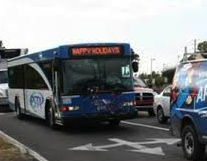Billion-dollar Florida transit plan promises light rail, but greenlights buses

By William Patrick | Florida Watchdog
TALLAHASSEE, Fla. — Pinellas County‘s 900,000 residents have the opportunity of a generation: for a simple “yes” vote they could be next-in-line in Florida to receive a modern light rail transit system.
GREENLIGHT?: A $100 million annual sales tax increase would deliver more buses, and in 10 to 15 years a 24 mile light rail.
Voters would also be signing up for a $100 million annual sales tax increase to deliver the 24 mile light rail connecting downtown St. Petersburg to downtown Clearwater. The tax would take effect Jan. 1, 2016.
But for at least the next decade — possibly 15 years — while the light rail is slated for construction, residents would have to settle for buses. Lots of buses.
It’s all part of an ambitious public transit proposal called the Pinellas Greenlight Plan, which includes a 65 percent permanent expansion of the Pinellas Suncoast Transit Authority‘s bus system.
The majority of Pinellas County residents do not regularly use the PSTA’s 195 buses, but that doesn’t mean they won’t pay.
The planned expansion would cost taxpayers $147.8 million in capital costs, plus $150 million for the buses and another $45 million for a new bus hub, according to PSTA’s cost estimates.
The theory, according to Bob Lasher, PSTA’s external affairs officer, is that if they build it, people will come aboard.
“If you can get decent frequency on routes, ridership goes up,” Lasher told Watchdog.org.
Lasher said expanded funding through a property tax increase already allowed the transit authority to drop wait times along U.S. Highway 19, the county’s major north-south corridor, from 30 minutes to 20 minutes. The result, he said, was a 50 percent increase in ridership.
“Right now most of our routes run once an hour,” Lasher said. “For most people that’s not a viable option.”
But that doesn’t mean 50 percent more people took the bus, Lasher admitted.
Though it’s nowhere to be found on PSTA’s website or the PSTA sponsored Pinellas Greenlight Plan’s website, ridership is calculated by adding the number of times a single person gets on a bus.
Transferring — common for trips not running along straight bus routes — increases ridership statistically even if it’s the same person. An individual who takes a roundtrip with two transfers accounts for four riders, according to PSTA’s math.
The new sales-tax funded plan would decrease bus waiting times along core routes to between 10 to 15 minutes. The rest of the system still would have wait times between 30 minutes to an hour. Weekend bus services would increase by 80 percent.
PSTA is banking on people giving up their cars in exchange for more frequent bus services.
Many PSTA news releases from 2013 announced record ridership, strong demand for buses and boisterous support for the Greenlight Plan, which was authored by PSTA. In December, PSTA announced record ridership of 1.16 million, a 3.2 percent increase from December 2012.
“We’ve been experiencing overcrowding on many routes during the day for quite some time now ,and the demand just keeps growing,” PSTA Chief Operating Officer James Bradford said in a statement.
Bradford’s claim was published next to a Pinellas Greenlight Plan advertisement and was based on anecdotal claims made by bus drivers.
The American Public Transportation Association, a Washington, D.C.-based nonprofit that advocates for public transit projects, reported that only 45 percent of weekday transit ridership equates to actual people. Using PSTA’s numbers, that translates into about 500,000 people using the system.
Pinellas County voters will decide the fate of the Greenlight Plan in a November referendum vote.
Contact William Patrick at wpatrick@watchdog.org or follow Florida Watchdog on Twitter at @watchdogfla Like Watchdog.org? Click HERE to get breaking news alerts in YOUR state!
The post Billion-dollar Florida transit plan promises light rail, but greenlights buses appeared first on Watchdog.org.







